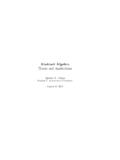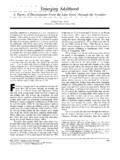Transcription of Usfos Hydrodynamics February2010
1 Usfos Hydrodynamics theory Description of use Verification 2 _____ Hydrodynamics 2010_02_10 Table of Contents 1. theory .. 4 Definitions and assumptions .. 4 Kinematics .. 6 Current .. 6 6 Depth profile .. 7 Direction 7 Time dependency .. 7 Current Blockage .. 8 8 8 Airy .. 9 Stoke s 5th order 18 Stream function .. 22 Irregular Wave .. 22 Grid Wave.
2 28 Riser Interference models .. 28 Initialization .. 28 Spooling of Irregular waves .. 29 Wave Kinematics 29 Force models .. 31 Morrison Equation .. 31 Influence of 33 Relative motion - drag force .. 33 Relative motion mass 34 Large volume 35 Coefficients .. 39 Drag Coefficients .. 39 Mass 40 Buoyancy .. 41 Archimedes .. 41 Pressure 41 Internal 42 Flooded 42 Free surface calculation .. 42 Marine 43 Modified hydrodynamic diameters .. 43 43 Quasi static wave analysis .. 43 Search for maxima .. 44 2. DESCRIPTION OF USE .. 45 hydrodynamic 45 50 3 _____ Hydrodynamics 2010_02_10 Current.
3 53 3. 54 Current .. 56 57 Airy wave kinematics deep water .. 57 Airy wave kinematics finite water depth .. 58 Extrapolated Airy wave kinematics finite water 59 Stretched Airy wave kinematics finite water depth .. 60 Stokes wave kinematics Wave height 61 Stokes wave kinematics Wave height 33 62 Stokes and Dean wave kinematics Wave height 30 and 36 63 Wave forces oblique pipe, 20m depth Airy deep water 64 Wave forces oblique pipe, 20 m depth Airy finite depth 66 Wave and current forces oblique pipe, 20 m depth Stokes 68 Wave forces vertical pipe, 70 m depth Airy finite depth 70 Wave forces vertical pipe, 70 m depth Stokes 72 Wave forces oblique pipe, 70 m depth Stokes 74 Wave forces oblique pipe, 70 m depth, diff. direction Stokes 76 Wave forces horizontal pipe, 70 m depth Airy 78 Wave forces horizontal pipe, 70 m depth Stokes theory .
4 80 Wave and current forces oblique pipe, 70 m depth Stokes 81 Wave and current forces obl. pipe 70 m depth, 10 el. Stokes 83 Wave and current forces relative velocity Airy theory .. 84 Wave and current forces relative velocity Stokes 85 Wave and current forces relative velocity Dean 86 Depth 88 Drag and mass coefficients .. 88 Marine 90 Buoyancy and dynamic pressure versus Morrison s mass term .. 91 Pipe piercing sea 91 Fully submerged 93 4 _____ Hydrodynamics 2010_02_10 1. theory Definitions and assumptions Figure Pipe cross-sectional data Figure Marine growth and internal fluid definitions tmg tmg = 0 tmg tmg (z)
5 F=1f=1f= fluid, equivalent uniformly distributed in element zDo Dhydro Di Internal fluid marine growth tmg 5 _____ Hydrodynamics 2010_02_10 Do Outer diameter of tube Di Inner diameter of tube s Steel density int Density of internal fluid w Density of sea water f Fill ratio of internal fluid CM Added mass coefficient CD Drag coefficient mg Average density of density of the marine growth layer including entrapped water tmg Thickness of marine growth The thickness of marine growth is based on element mid point coordinate according to marine growth depth profile hydrodynamic diameter.
6 Net hydrodynamic diameter is assumed either equal to the tube diameter or as specified by input: __ohudro nethydo netDDD hydrodynamic diameter for wave force calculation, Morrison s equation: _2hydrohydro netmgDDt draghydroDD Diameter for drag force calculation masshydroDD Diameter for mass force calculation Masses: 224soiDD Mass intensity of tube 22__24mghydro netmghydro netDtD Mass intensity of marine growth 2int4iDf Mass intensity of internal fluid, distributed uniformly over element length 214wMhydroCD hydrodynamic added mass for dynamic analysis Added mass intensity for each element is predefined. Motion in and out of water is taken into account on node level (consistent or lumped 6 _____ Hydrodynamics 2010_02_10 mass to nodes).
7 Only submerged nodes contribute to system added mass. Buoyancy forces: _buoyancyhydro netDD Buoyancy diameter (excluding marine growth) 24wbuoyancygD Buoyancy intensity of tube 22__24whydro netmghydro netgDt D Buoyancy intensity of marine growth Buoyancy forces are scaled according to BUOYHIST in dynamic analysis Gravity forces 224soigDD Weight intensity of steel tube 22__24mghydro netmghydro netgDt D Weight intensity of marine growth 2int4igDf Weight intensity of internal fluid (distributed uniformly over element length) Gravity forces are scaled according to relevant LOADHIST for gravity load case in dynamic analysis Kinematics Current Introduction Current is specified speed depth profile and direction. The current speed is added vectorially to the wave particle speed for calculation of drag force according to Morrison s equation. 7 _____ Hydrodynamics 2010_02_10 Depth profile A possible depth profile for current is illustrated in Figure Values are given at grid points at various depths.
8 The depth is specified according to a z- coordinate system, pointing upwards and with origin at mean sea surface level. Tabulated values are taken from the table according to the element mid point. For intermediate depths values are interpolated. If member coordinate is outside the table values, the current speed factor is extrapolated. Because wave elevation is taken into account the current speed factor should be given up to the maximum wave crest. Figure Depth profile for current speed factor coefficient Direction Profile Current is assumed to be uni-directional. The direction is specified in the same format as the wave direction. Time dependency Current speed may also be given a temporal variation. The entire depth profile is scaled this factor which is given as tabulated values as a function of time. Interpolation is used for time instants between tabulated points.
9 Scaling factor at actual position 8 _____ Hydrodynamics 2010_02_10 Current Blockage Waves Introduction The following wave theories are available in Usfos : - Linear (Airy) wave theory for infinite, finite and shallow water depth - Stokes 5th order theory - Dean s Stream function theory - Grid wave this option allows calculation of fluid flow kinematics by means of computational fluid dynamics (CFD). The forces from the kinematics may be calculated using Usfos force routines Higher order wave theories are typically giving wave crests which are larger than wave troughs. This influences both the wave kinematics as such as well as actual submersion of members in the splash zone.
10 The most suitable wave theory is dependent upon wave height, the wave period and the water depth. The most applicable wave theory may be determined from the Figure which is taken form API-RP2A (American Petroleum Institute, Recommended Practice for Planning, Designing and Constructing Fixed Offshore Platforms) 9 _____ Hydrodynamics 2010_02_10 Figure Applicability of wave theories Airy Airy waves are based on linear wave theory . Consider wave propagating along positive x-axis, as shown in Figure The origin is located at sea surface with global z-axis pointing upwards. The free surface level is given by coshtkx ( ) regardless of water depth.










